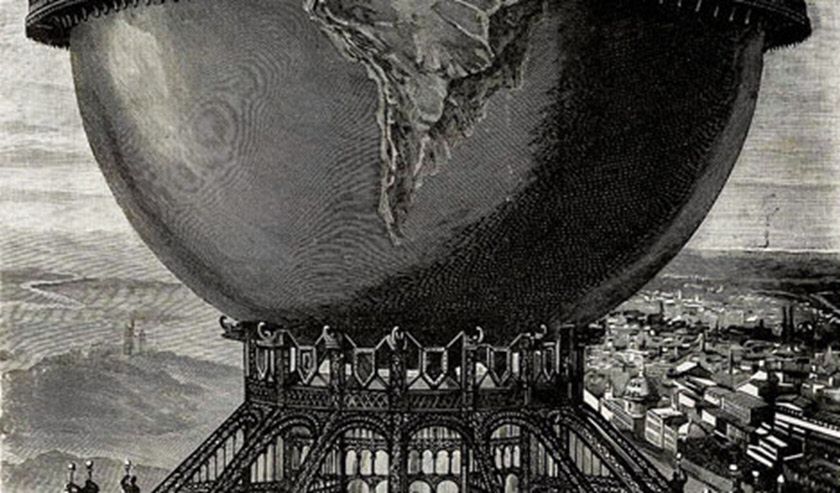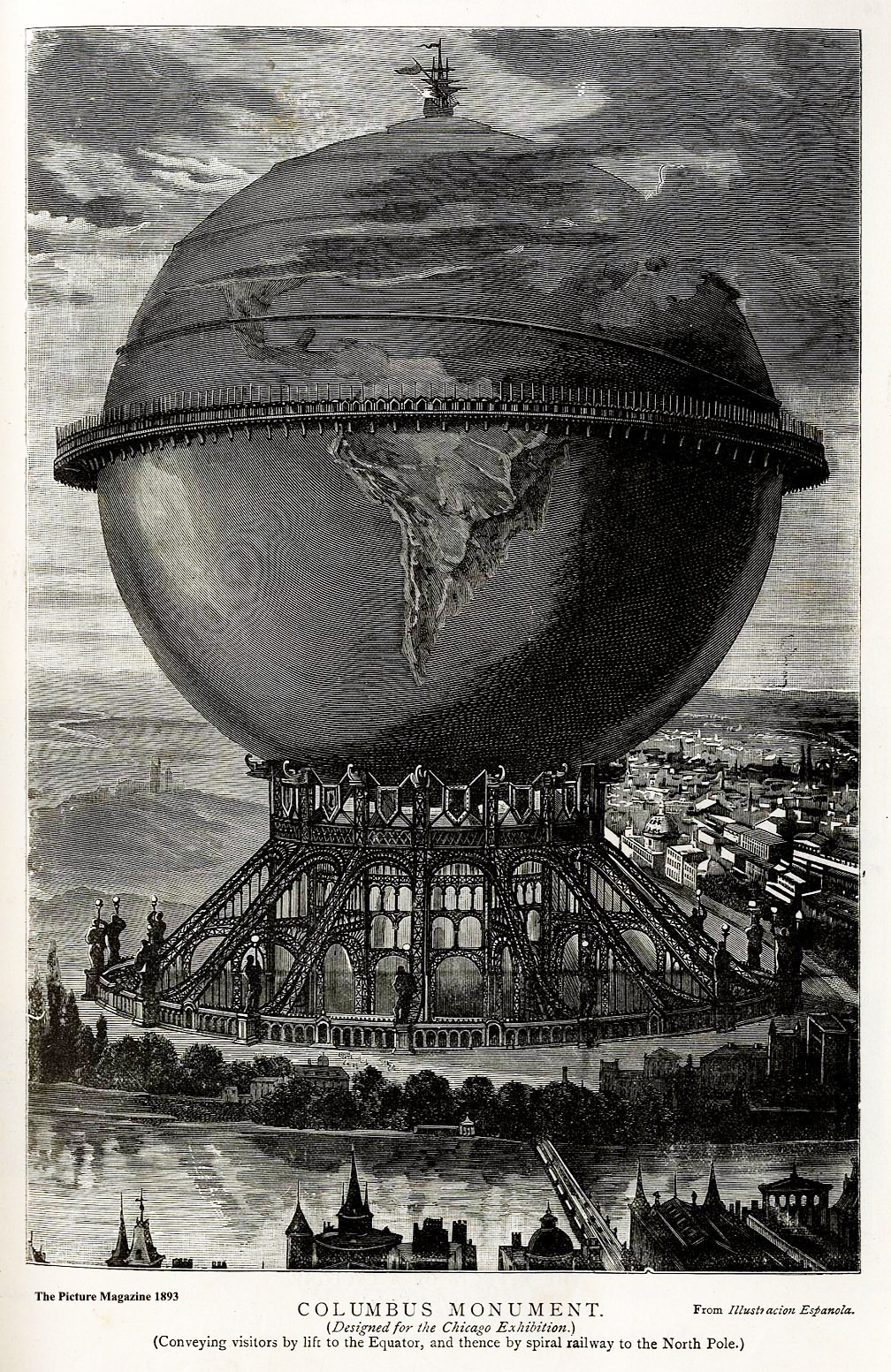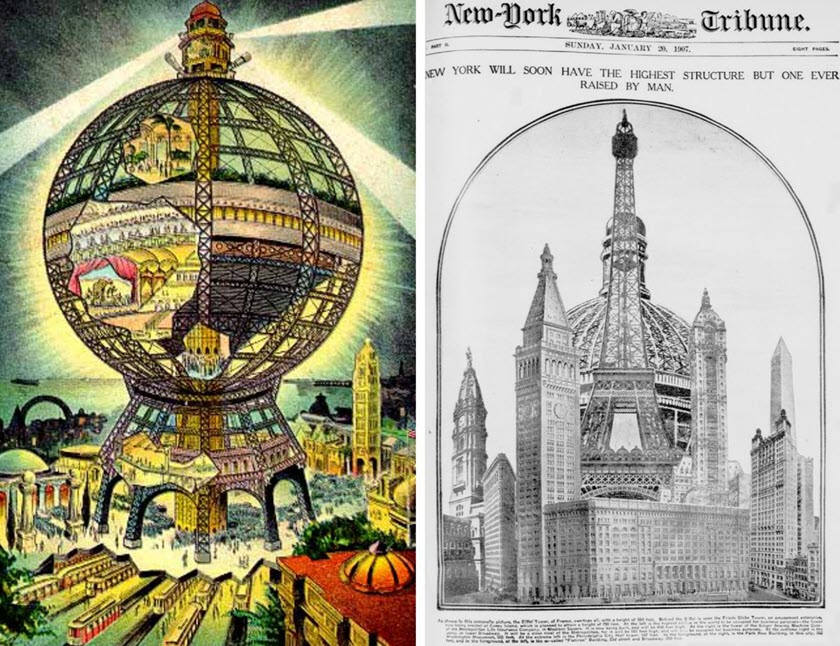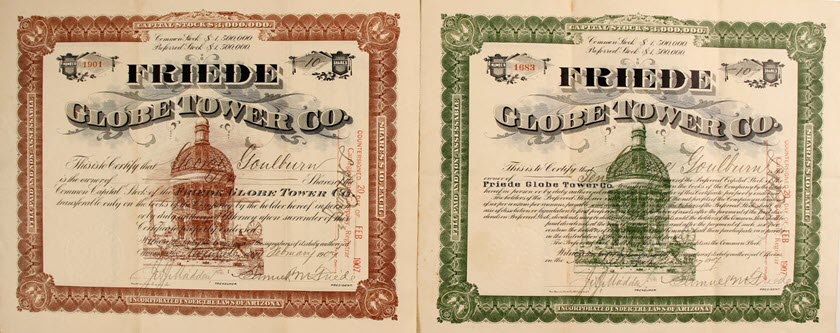Fantastic Monumental World Fair Globes


Within the period between 1891 and 1903, plans were made to construct two different monstrously huge iron buildings in the shape of the globe, for two different World Fairs.
Neither came to pass.
The World’s Columbian Exposition (WCE) — also called The Chicago World’s Fair — was held to celebrate the 400th anniversary of Columbus’s arrival in the “New World”. Covering some 600 acres in Chicago, the fair opened on May 1, 1893, and ran through October 30th of that year. More than 27 million people attended.
In 1891, it was announced that an utterly fantastic structure would be built for the fair, to be called the Columbus Monument. The British Printer magazine described it thus:
“The Americans, with their natural love of ‘big things’ have decided to celebrate the 400th anniversary of the discovery of their continent by Columbus by the erection of a monument, for which size, expense, and novelty shall ‘lick all creation.’
Grand as was the Eiffel Tower, it cannot for a moment be compared with the massive yet graceful structure to be erected at the World’s Fair at Chicago. The circumference of the globe . . . will be two-thirds of a mile, its diameter being equal to the height of the Eiffel Tower. The globe will rest on a graceful pedestal nearly 300-ft. high, and will be capped by a fully-rigged ship, the total height being about 1,400 feet. A gallery will run around the globe at the Equator, and an inclined railway, nearly four miles long, will wind its way along the outside, from the Equator to the North Pole.
The cost of this stupendous monument, which is designed by a fellow countryman of Columbus, Albert de Palladio, is estimated to reach about £1,000,000, and about £160,000 will be required in addition for lifts and other machinery.
An observatory will be placed at the summit; a base statue of Columbus will stand in the center of the base and under the globe, and restaurants will be dotted here and there at more or less exalted positions.” (The British Printer, Vol. 4, o. 21, May, June 1891, p.100)
The ship at the top was meant to represent Columbus’s ship.
I have so far been unable to track down additional information about this planned monument which never was built, or about its proponents. The only globe I’ve come across which was actually on display at the WCE was this small globe circled by agricultural implements, captured in a stereo view by B. W. Kilburn.
The Louisiana Purchase Exposition of 1904, also known as The St. Louis World’s Fair, ran from April 30, 1904, through December 1. It was the largest such fair ever held to date, with more than 1,500 buildings.
St. Louis businessman C. F. Blanke of the Blanke Coffee Company proposed to build a different huge globe structure, even issuing a postcard in color known used in 1902:
In addition, there was at least one trade card issued which depicted the Blanke Aerial Globe:
“Beside (the Aerial Globe), the promoters say, the Eiffel Tower and the Ferris Wheel are crude engineering feats. The Aerial Globe will be an immense steel structure, 700 feet high from the stone base to the roof of the observation tower on the top. At a height of 110 feet will be a roof garden about 1,000 feet in circumference. On that floor will be two restaurants, one German and the other American, and two theatres. At a height of 295 feet, a coliseum will be located, with iron-bridges walks around the globe, giving a complete view of the grounds. Below will be two regular circus rings and a race track surrounding them, and underneath the tiers of seats will be a menagerie viewed from the circular walk. At an elevation of 420 feet will be a great music hall and at 450 feet a palm garden.”
“Mr. Blanke and Samuel M. Friede have organized a company with $1,500,000 capital, named the Friede-Blanke Aerial Globe Company, and have begun active work to have this feature constructed.” (New York Times, August 29, 1901) Samuel Friede was an architect and inventor. The structural engineer for the project was to have been Albert Borden.
For comparison, the Eiffel Tower cost $1,300,000 to construct in 1889, and the Ferris Wheel constructed for the 1893 World’s Columbian Exposition cost $500,000.
In the September 1901 World’s Fair Bulletin, which reported on all the current details of the planning for the 1904 exposition, the discussion about the proposed globe announced that a display about the huge project would be shown beginning on September 9, 1901. A blueprint “showing the actual steel construction” was said to be the largest blueprint in the world, at 5 feet x 10 feet. “Small photographs of the Friede Aerial Globe will be given away to the public.”
I am aware of a bottle in the shape of the proposed Friede-Blanke Aerial Globe, put out by the Blanke Coffee Company.

Following the St. Louis fair, Samuel M. Friede announced a plan to build a similarly fantastic 700 feet tall tower on Coney Island in New York. He issued stock in the Friede Globe Tower Company (in the State of Arizona, for some legal reason), promising investors a ground-floor opportunity to get in on an investment that would pay 100% interest per year! He issued promotional postcards.

The Globe Tower would have been the largest building in the world. The proposed structure had a long list of amazing planned features, including the largest ballroom in the world and a hotel around the Equator with soundproofed rooms. Underground, the complex would house a subway station, a railroad station, parking garages, and a railroad branch line connected to a boat pier. After a cornerstone laying ceremony on May 26, 1906, Friede leased a piece of property on Coney Island and poured some footings. When investors grumbled about a lack of progress, he held another ceremony on February 17, 1907.
By 1908, it had become clear that the entire enterprise was an elaborate scam. Company treasurer Henry Clay Wade was convicted for embezzling proceeds from the stock sales. He testified during a subsequent investigation that other amounts of money had been split up between Friede, architect Burdette, head bookkeeper Price, and Coney Island’s Chief Inspector of Elevators, a man named Langan.
